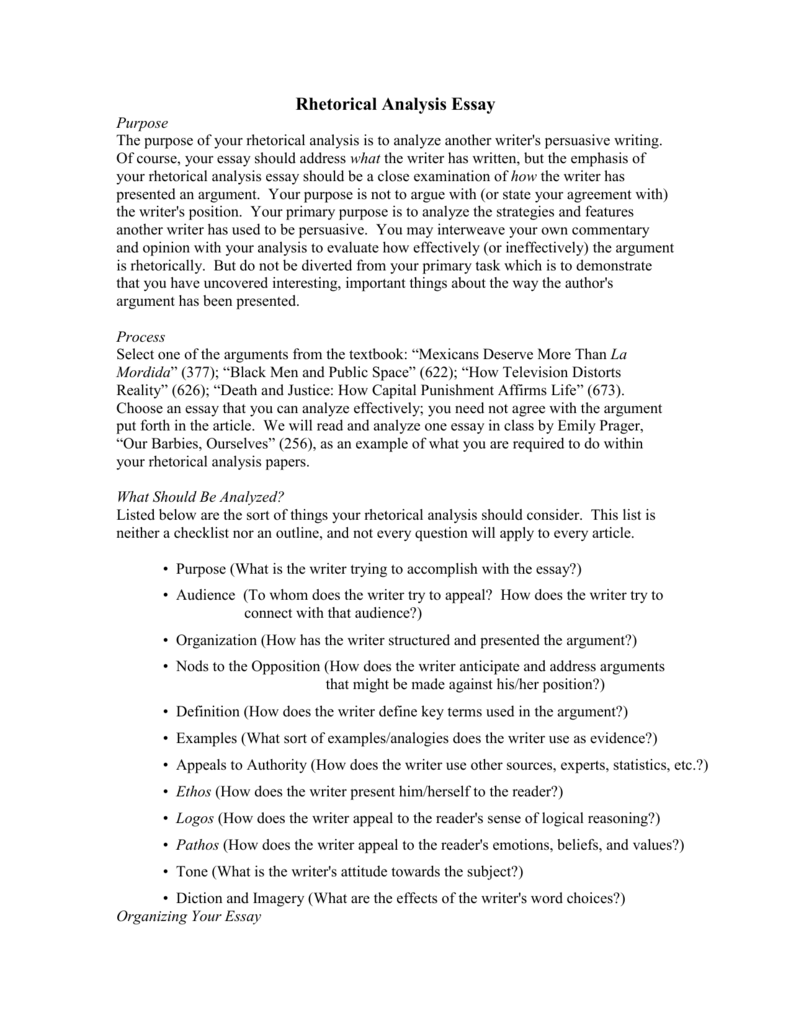
Rhetorical Analysis Essay Example: AP Language. Rhetorical analysis done in AP Language and Composition is one of the biggest tasks a student can ever get. On the same hand, drafting it in a proper way is also necessary to get good grades. Look at the example given below and see how a well-written rhetorical analysis essay is written for AP language Aug 28, · Concluding a rhetorical analysis. The conclusion of a rhetorical analysis wraps up the essay by restating the main argument and showing how it has been developed by your analysis. It may also try to link the text, and your analysis of it, with broader concerns. Explore the example below to get a sense of the conclusion. Rhetorical analysis conclusionReviews: 2 Writing a rhetorical analysis essay is more complex than an ordinary academic essay. It critically analyzes the persuasive means used to convince an audience and evaluates how well they work for their intended purpose. Like other traditional essays, a rhetorical analysis essay outline also consists of three major parts such as: Introduction
Best Rhetorical Analysis Essay Example & Sample Papers
Involve all the variety of vocabulary that is easily understood by the rhetorical analysis essay. This is an excellent method to get a good score from your instructor. Avoid to over-burden the rhetorical essay with irrelevant information. Introductory paragraphs and conclusions ought to be the smallest parts. Do not understand this statement as usual. This may seem very simple, rhetorical analysis essay, but anyone, including the teacher, of course, likes to read the content with punctuation marks and grammar.
This would be best to write the rhetorical analysis essay in the present tense. This is not mandatory for an academic paper. Try to use reliable resources as well as updated writing methods. It is crucial to devote some valuable time to understand the various procedures. Any instance of rhetorical analysis essay involves strong arguments, that are consist of strong descriptive adversative and attributes. It is the last thing, but not at least one. When you write a rhetorical analysis essay, keep in mind that the main purpose of your essay is to describe the impact of each tool.
This is the last thing that a reader reads and takes it as a count for a great deal. A reasonable conclusion can save a rhetorical analysis essay and fix rhetorical analysis essay seal on a good essay writing. Revision is one of the most significant pieces of composing a rhetorical analysis essay. There are various methods to clear your final writing. How to Write a Rhetorical Analysis Essay, rhetorical analysis essay. What is a Rhetorical Analysis Essay? Use Present Tense. Applying Up-to-Date Methods. Strong Words to Apply. Proofreading and Editing. Learn More About How to Write a Rhetorical Analysis Essay.
AP English Rhetorical Analysis Essay Overview
, time: 2:30+ Interesting Rhetorical Analysis Essay Topics ()

Conclusion. This is the last thing that a reader reads and takes it as a count for a great deal. A reasonable conclusion can save a rhetorical analysis essay and fix a seal on a good essay writing. Arrow. Proofreading and Editing. Revision is one of the most significant pieces of composing a rhetorical analysis essay Writing a rhetorical analysis essay is more complex than an ordinary academic essay. It critically analyzes the persuasive means used to convince an audience and evaluates how well they work for their intended purpose. Like other traditional essays, a rhetorical analysis essay outline also consists of three major parts such as: Introduction Feb 13, · Analysis explains how quote supports thesis; Transition and topic sentence about fourth point from thesis; Quote illustrates how the author uses appeal to ethos; Analysis explains how quote supports thesis; Conclusion returns to the ideas in the thesis and further develops them; Last sentence returns to the hook in the introduction
No comments:
Post a Comment